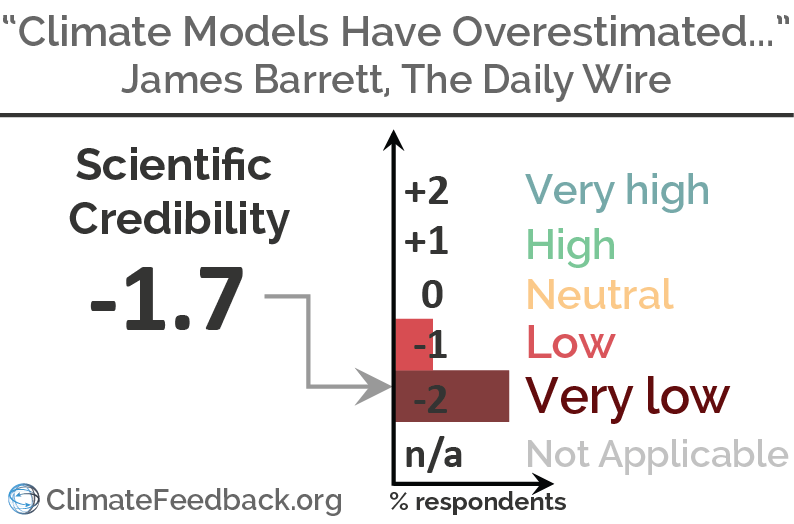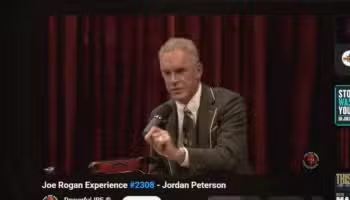- Climate
Daily Wire article misunderstands study on carbon budget (along with Fox News, The Telegraph, The Daily Mail, Breitbart…)
Reviewed content

Headline: "Climate Scientists: Climate Models Have Overestimated Global Warming"
Published in The Daily Wire, by James Barrett, on 2017-09-19.

Scientists’ Feedback
SUMMARY
This story at The Daily Wire describes a new study that evaluates the remaining amount of greenhouse gas that we can emit before global temperature rises to 1.5 °C above pre-industrial times. The study suggests that we may have a little more room in the so-called “carbon budget” than previously estimated.
Scientists who reviewed the Daily Wire article found that it greatly misinterpreted the study by saying that it showed that climate projections have overestimated warming. This is incorrect. The study does not conclude that climate models are overly sensitive to warming, or that future warming will be less than projected. Instead, it investigates a discrepancy between the total amount of greenhouse gas emitted since the Industrial Revolution in the models and in the real world. This difference in estimated past emissions affects the study’s calculation of the remaining “carbon budget” for future emissions.
According to the study’s authors, articles implying their work “indicates that global temperatures are not rising as fast as predicted” (as published in Fox News, The Telegraph, The Daily Mail, Breitbart…) do not represent their work. Describing the inaccurate coverage of their study, two of the authors wrote, “Crucially, the reason for the correction [of the carbon budget] was not that we had a new estimate of the climate response, or warming per tonne of CO2 emitted—we used exactly the current consensus range—but that we took better account of past emissions and where human-induced warming has got to already.”
See all the scientists’ annotations in context
REVIEWERS’ OVERALL FEEDBACK
These comments are the overall opinion of scientists on the article, they are substantiated by their knowledge in the field and by the content of the analysis in the annotations on the article.

Assistant Professor, St. Francis Xavier University
The article selectively quotes from interviews and scientific papers to create the false perception that climate models significantly overestimate the rate of warming. The article also falsely implies that the cited paper is about the so called “hiatus” while the paper is actually about the carbon budget for the 1.5 ºC target.

Professor, University of Exeter
[Prof. Friedlingstein is a co-author of the Millar et al study described by the Daily Wire story.]
Bad coverage of the Nature Geoscience article. The title and first 3 paragraphs are misleading. It seems very clear that the author of this article did not read the scientific article he is reporting on.
Notes:
[1] See the rating guidelines used for article evaluations.
[2] Each evaluation is independent. Scientists’ comments are all published at the same time.
Featured Annotations
“Climate Models Have Overestimated Global Warming”

Professor, University of Exeter
The title does not truly reflect the article in Nature Geoscience. The issue is not that the models are too warm by 2015. CMIP5 models are on the warm end, yes, but that’s not the main issue here. The article explains that problem comes when looking at both cumulative CO2 emissions and associated warming. The cumulative CO2 emissions simulated by the models only reach 545 GtC (the present-day value) after 2020, by which time the CMIP5 ensemble-mean human- induced warming is over 0.3 ºC warmer than the central estimate for human-induced warming to 2015.
“The models end up with a warming which is larger than the observed warming for the current emissions.”

Professor, University of Exeter
That’s a more accurate description of the study. “For the current emissions” is the key element.
“the climate models have overestimated the amount of global warming and failed to predict what climatologists call the warming ‘hiatus’”

Professor, University of Exeter
Except that the report (the paper published in Nature Geoscience) never said that. The paper does not describe modelled warming vs. observations over the “hiatus” period.

Principal Research Fellow, National Centre for Atmospheric Science
Recent media headlines have again discussed the issue of whether climate models are overly sensitive to greenhouse gases. These headlines have misinterpreted a study by Millar et al. which was discussing carbon budgets to limit global temperature rise to 1.5°C above pre-industrial levels.
A recent study by Medhaug et al. analysed the issue of how the models have performed against recent observations at length and largely reconciled the issue. An overly simplistic comparison of simulated global temperatures and observations might suggest that the models were warming too much, but this would be wrong for a number of reasons.
In the Medhaug et al. paper they show the range of models (blue shading in figure with median in light blue), compared with the HadCRUT4 observations and their estimated uncertainty (orange shading with light orange line). There are a number of well understood reasons why the light orange line might not follow the light blue line, namely: radiative forcings, variability, observational biases and choice of reference period. [Read more…]

Figure 5 from Medhaug et al. showing CMIP5 simulations and observations (HadCRUT4) of global temperature.
- Medhaug et al (2017) Reconciling controversies about the ‘global warming hiatus’, Nature
“The report, published in the journal Nature Geoscience on September 18, acknowledges that most of the models of warming trends failed to predict the ‘slowdown’ in warming post-2000, resulting in less pronounced warming than predicted and thus more room in the CO2 ‘emissions budget’ for the coming decades.”

Assistant Professor, St. Francis Xavier University
Millar et al. (2017) does not mention the “hiatus” nor a slow-down in global warming post 2000, but is instead focused on estimating the remaining carbon budget compatible with remaining below the 1.5 ºC target set by the Paris agreements. Instead of looking at the carbon budget from pre-industrial times to present, the study uses the present decade (2010-2019) as the reference period and asks: How much more CO2 can we emit and remain below an addition 0.6 ºC of warming?
The study found that the remaining carbon budget for the 1.5 ºC target was about ~200 GtC, which is larger than that found using pre-industrial times as the reference period. This implies that either (1) models may underestimate the historical strength of natural carbon sinks, (2) that the historical cumulative CO2 emissions (545±150 GtC, 2 standard deviations) are at the low end of the uncertainty bound, (3) or a combination of these and other factors.

Group Leader, Max Planck Institute for Biogeochemistry
There is an ongoing discussion about the reasons for models to overestimate the rates of tropospheric temperature in the early 21st century. In a recent study, Santer and colleagues* show that the observed cooling relative to the model predictions could be explained by both internal variability in the climate system (transition to a negative phase of the Interdecadal Pacific Oscillation in ca. 1999 and other modes) and by systematic errors in the models’ forcing that lead to an overestimation of the radiative forcing in the early 21st century. These errors include a later start of a minimum in solar cycle activity than have been assumed in CMIP5 simulations, and the cooling effect of both human and natural aerosol emissions. Schmidt and colleagues* have shown that if adjusted for such effects, CMIP5 models reproduced the slow-down of the warming trends (figure below).

Source: Schmidt et al (2014)*
- Santer et al (2017) Causes of differences in model and satellite tropospheric warming rates, Nature Geoscience
- Schmidt et al (2014) Reconciling warming trends, Nature Geoscience
“over 20 years of almost no change in temperatures”

Group Leader, Max Planck Institute for Biogeochemistry
Bastos
There has been a slow-down in global mean surface (troposphere) temperatures, but this does not call into question the fact that the Earth-system as a whole is warming. In fact, during the so-called “hiatus”, the net radiation imbalance in the top of the atmosphere persisted (implying that warming would continue even if emissions were to stop). In fact, at the same time that warming in the troposphere stalled, ocean heat content increased, especially in deeper layers:

The fact that oceans took more heat from the atmosphere helps to explain the slow-down of warming at the surface. This seems to be, at least partly, explained by natural variability in the ocean (see here). Trenberth* argued, thus, that natural variability in the climate system makes the global mean surface temperature record increase in steps, rather than in a linear way. In another study, Yan and colleagues* analysed the redistribution of heat during the “hiatus” period and concluded that: “[…] the term ‘global warming hiatus’ is a misnomer, although we will continue to use the widely used phrase to describe the slowdown or pause in the increase of GMST in the late 20th to early 21st century, with quotation marks. Alternatively, we would like to suggest to the climate community to use ‘global surface warming slowdown’ instead in the future to avoid confusion. There is no absolute consensus on the specific oceanic sink for the excess heat that led to the slowdown in rising GMST (the Southern Ocean may be worth further attention though), but there is a general agreement in this group and in the literature that rather than a ‘global warming hiatus,’ the slowdown of GMST increase in 1998–2013 was a result of the increased uptake of heat energy by the global ocean during those years.”
- Trenberth (2015) Has there been a hiatus?, Science
- Yan et al (2016) The global warming hiatus: Slowdown or redistribution?, Earth’s Future
“The report follows a study by another team of climate scientists published in June 2017 [Santer et al] that likewise determined that the actual increases in warming post-2000 was ‘generally smaller than trends estimated’ from the models.”

Assistant Professor, St. Francis Xavier University
Santer et al. (2017)* attributed the small discrepancy between climate model simulated warming and observed warming to differences in scenario forcing. (i.e., the trajectory of CO2, methane, other greenhouse gasses and aerosols) The models were given the forcing that actually transpired between year 2000 and the present day. That is, the study suggested that the discrepancy is not a problem with our models but a problem with measuring emissions of forcing agents and discrepancies between future scenarios and what actually transpired since the scenarios were designed.
- Santer et al (2017) Causes of differences in model and satellite tropospheric warming rates, Nature Geoscience
“The team of climate scientists notes that in failing to predict the warming ‘hiatus’ in the beginning of the 21st century, the Intergovernmental Panel on Climate Change (IPCC) models overestimated temperature increases…”

Professor, University of Exeter
The word hiatus is not even mentioned in the paper!
Prof. Piers Forster, one of the authors of the Millar et al study, asked by Carbon Brief to further clarify some of the paper’s findings and methodologies in light of the media coverage:
Our paper focused on carbon emissions and the feasibility of limiting future warming to 1.5 ºC. We concluded that we would only succeed with strengthened policies to bring rapid and sustained emission reduction.
We made estimates of the allowable future emissions of carbon before we pass 1.5 ºC. To do this we made assumptions about past warming, exploring different levels of warming from 2015 to address the role of uncertainty in historic warming levels. Readers should note that our method is only one way of computing the budget. The IPCC special report on 1.5 ºC will need to consider it alongside other lines of evidence. The usefulness of the carbon budget concept will also likely be assessed given its inherent uncertainty due to the uncertain historic warming.
I think some press reporting is misleading as our paper did not assess climate impacts or climate model performance. Rather, our paper confirms the need for much increased urgent action from around the world if society stands a chance of limiting warming to 1.5 ºC.



